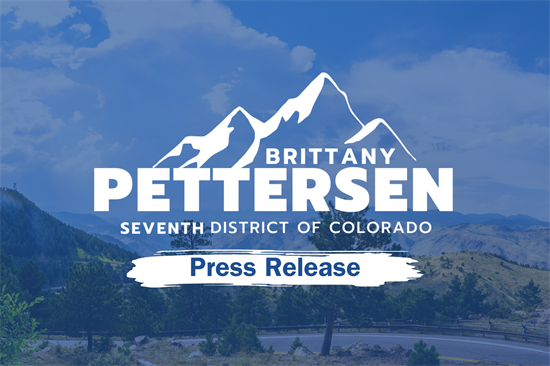WASHINGTON – U.S. Representative Brittany Pettersen (CO-07) this week passed critical water infrastructure provisions - including a $50 million investment in Fremont County - through the House of Representatives with bipartisan support.
The Water Resources Development Act (WRDA) is a legislative package that provides Members of Congress the opportunity to authorize U.S. Army Corps of Engineers Civil Works projects to improve the nation’s waterways and water infrastructure, flood and storm protection, nation’s ports and harbors, the inland waterway navigation network, and other water resources infrastructure.
Included in WRDA is Pettersen’s bill - the John Griffin Regional Reservoir Project Act - which authorizes a $50 million investment to reconnect John Griffin Regional Park in Cañon City to the Arkansas River ecosystem. Pettersen worked on this provision after hearing directly from Fremont County officials about their plans to create a reservoir within John Griffin Regional Park and the need for federal assistance.
Pettersen also successfully included a provision to create new community project advisor positions to support communities with federal water infrastructure projects and provision to include low-head dams in the National Inventory of Dams to protect recreators, such as rafters and kayakers.
“As a Representative, it’s so important to me to spend time in our communities, hearing from people at home and finding ways we can work together to solve our greatest challenges,” said Pettersen. “We know that in Colorado - especially areas like Fremont County - improving our water infrastructure is critical to our way of life. I’m proud to have the opportunity to carry through the great work of Cañon City officials and get the John Griffin Regional Reservoir one step closer to reality. I’ll keep working to bring these kinds of investments back home to our communities.”
In late May, Rep. Pettersen visited John Griffin Regional Park in Cañon City, where she heard updates from officials about efforts to reconnect John Griffin Regional Park’s channels to the Arkansas River.
“Creating a reservoir within John Griffin Regional Park will meet three critical needs in our community: increase our water storage, create new recreational opportunities, and restore the degraded ecological habitat along the Arkansas River,” said Travis R Payne, Water Superintendent, Cañon City. “This project is a truly once in a lifetime opportunity for our community, and we appreciate the Congresswoman’s willingness and dedication in moving the project forward.”
“Since being elected to represent Fremont County, Congresswoman Pettersen has consistently shown up and listened to the needs of our community,” said Preston Troutman, Cañon City Mayor. “When Cañon City officials approached her about our plan to create a reservoir within John Griffin Regional Park she took immediate action – and now, we’re one step closer to breaking ground. Thank you to Congresswoman Pettersen for investing in our community.”
“The City is grateful for the Congresswoman’s support and for giving back to Fremont County and Colorado,” said John Hamrick, Cañon City Mayor Pro-Tem. “This summer, I met with Congresswoman Pettersen and Cañon City officials to discuss her work to bring funding for this critical project home. The announcement of Rep. Pettersen’s bill passing the House brings us one step closer to breaking ground.”
Additional background on Pettersen’s WRDA provisions:
John Griffin Regional Reservoir Project Act: Included in WRDA is Rep. Pettersen’s bill authorizing a $50 million investment to reconnect the John Griffin Regional Park in Cañon City channels to the Arkansas River ecosystem. Today, landscape scars in John Griffin Regional Park demonstrate that this area once had a wide floodplain with braided channels. side channels still exist, but are disconnected from the Arkansas River, leading to potential floods and other natural disasters. This investment will reconnect remaining side channels and boost water storage, create a natural barrier to protect against wildfires, and create more space for recreational use.
Establishing Community Project Advisors: This provision creates an office within the U.S. Army Corps of Engineers to provide communities with advisors to help them navigate federal processes as they develop water infrastructure plans and projects. These project advisors will give guidance to local patterns on accessing federal programs, services and other assistance that the U.S. Army Corps of Engineers can provide.
Low-head Dam Inventory in the National Inventory of Dams: Low-head dams can be difficult to see and often can cause turbulent waters that can pose a risk to swimmers, kayakers, and other recreators. Pettersen pushed to clearly define low-head dams in WRDA, ensuring that they are reflected in the National Inventory of Dams. The National Inventory of Dams is a database that documents dams, including both maps and a repository of dams across the country. This inclusion of low-head dams in the National Inventory of Dams will help protect recreators, such as rafters and kayakers, by identifying potentially dangerous low-head dams.



